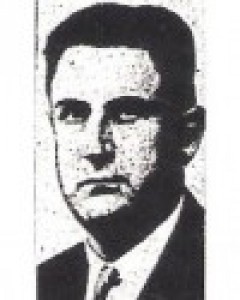
Next Day's Front Page - The Los Angeles Times
The specific event that will cause the executions begins on September 19, 1937, outside of Warden Larkin's office, where forty convicts are waiting their turn to discuss with the penologist their upcoming parole hearings ... a regular, routine event ... but not on the 19th. Break planned, seven inmates suddenly produce shank knives (they have ten, and two carved wooden guns) and stab to death Guard Harry Martin (40) when he attempts to intervene, and then take captive the warden and Captain of the Guards, William J. Ryan. So far, so good, but things go south for the convicts when they leave the office area and step outside thinking their hostages are a ticket to freedom. Alerted by the attack and murder, the men step into the yard and discover they are in the gun sights of several guards on the wall, and are surrounded by another group of guards on the ground bearing heavy, lead-tipped riot canes. Trained already not to negotiate with cons over hostages, that policy is reinforced to all the guards when Warden Larkin calls out to anyone within earshot that no one is to open the prison's gate, even if it costs him his life. Which of course, it does. Responding to orders, the wall guards open up on anyone in the yard looking hostile with rifles and .30-caliber machine guns (two of the seven escapees are shot to death in the ten minute melee that takes place ... 25-year-old Clyde Stevens and 33-year-old Wesley Eudy). The convicts in turn respond by stabbing and strangling the warden (he dies in a local hospital later that night at the age of 46) and knifing the Captain of the Guards (Ryan will survive after a week of medical emergency procedures on his shredded lungs ... helped by two convicts who supply blood transfusions to the guard) ... then once down, more payback comes the convict's way from guard boots, fists, and the canes ... beatings the stop just short of killing their recipients.

Folsom

Weapons Used In The Escape Attempt

Warden Larkin

Headlines

Martin

Heroes (They Look A Little Ancient To Me)
Mended enough to receive more justice, at trial it comes out that the ringleader of the break is the notorious 1920s and 1930s public enemy, Ed Davis ... a career criminal from Oklahoma that has a resume of nefarious behavior that includes a stint in the Oklahoma state prison, the murder of police officer J. R. Hill, an escape from the Oklahoma state prison, a stint in the Kansas state prison, an escape from the Kansas state prison (along with major outlaws, Harvey Bailey, Robert "Big Bob" Brady, Jim Clark, and Wibur Underhill), two robberies as a member of the Bailey-Underhill gang, a string of one-man bank robberies in Texas that get him the nickname of "The Fox," and a Los Angeles, California (where he had retired, but running out of Texas loot, he gets back in the game) robbery and kidnapping that sends him to Folsom for life. Slam dunk for the jury, Davis (35), and his compatriots, Albert Kessel (28), Robert Cannon (28), Benny Kucharski (31), and Fred Barnes (39) are all sentenced to death in the state's new gas chamber at the San Quentin Prison.

Davis

Three Of The Perps
Hanging deemed too barbaric with all its twitching and bowel releases, accidental occasional decapitations, and slow strangulations, the state of California has recently switched to executions by gas, but the gas chamber that has been built has only two seats within it (labeled "A" and "B") and takes hours afterwards to fumigate, so the men's executions are broken up with Kessell and Cannon scheduled to leave first, Kucharski and Barnes next (they go on 12/9/1938), and Davis saved for last (executed on 12/16, he leaves behind a last note in his cell stating, "No regrets for Old Ed. All considered, my conscience is now resting easy.").

Davis
Resigned to their fate, Kessell and Cannon, in adjoining cells behind the gas chamber spend their last evening of life playing records, singing, and talking ... and ten minutes before their scheduled execution, they are allowed to smoke a cigar and have a shot of whiskey. Barefooted, Cannon is marched into the chamber first and cinched to his seat, and moments later Kessell follows, muttering "Quite a congregation here" as he notes all the witnesses outside the chamber. Both men told to count to ten, breathe deeply, and not to fight the gas, Cannon complies and appears to leave peacefully, but Kessell fights his death, holding his breathe as long as possible and fighting the fumes to no avail. Both men, the first to be executed in California using cyanide gas, are dead within 15 minutes of the door to the chamber being shut ... and then the recriminations begin (though it will take until the 1990s for the method to be replaced by lethal injection). Hanging replaced, the newspapers are soon filled with horrifying stories of men struggling against their bonds as they cough, gasp. wheeze, convulse, and turn red and blue as they suffer obviously painful deaths in the chamber (some articles even request a return to hangings).

The First California Gas Chamber

Adios!!!!!!!!!!!!!!!!!!!!!
12/2/1938 ... for the first time in California, gas is used for convict executions ... and the Folsom Five begin leaving!
No comments:
Post a Comment